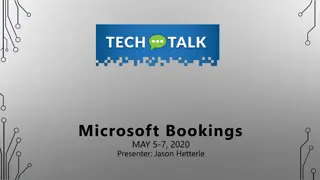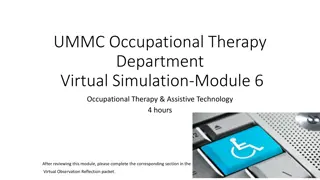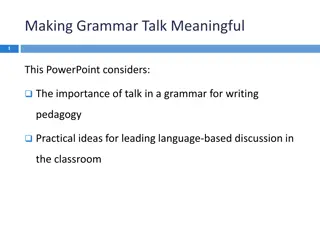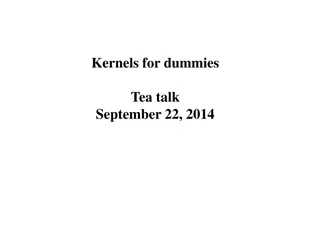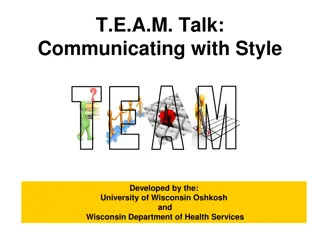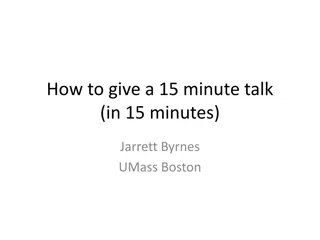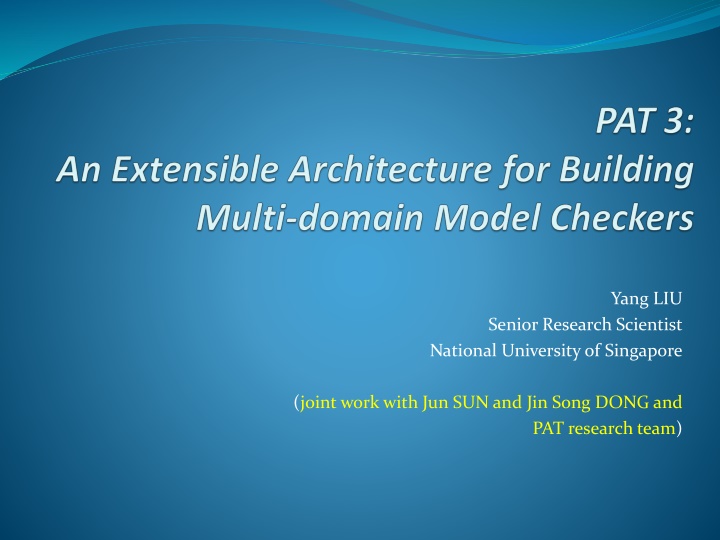
Advanced Model Checking Frameworks Developed at National University of Singapore
Explore the cutting-edge research on model checking by Yang Liu, a Senior Research Scientist at the National University of Singapore, in collaboration with the PAT research team. Discover the challenges and advancements in model checking tools like PAT, designed for formal verification in various system types.
Download Presentation

Please find below an Image/Link to download the presentation.
The content on the website is provided AS IS for your information and personal use only. It may not be sold, licensed, or shared on other websites without obtaining consent from the author. If you encounter any issues during the download, it is possible that the publisher has removed the file from their server.
You are allowed to download the files provided on this website for personal or commercial use, subject to the condition that they are used lawfully. All files are the property of their respective owners.
The content on the website is provided AS IS for your information and personal use only. It may not be sold, licensed, or shared on other websites without obtaining consent from the author.
E N D
Presentation Transcript
Yang LIU Senior Research Scientist National University of Singapore (joint work with Jun SUN and Jin Song DONG and PAT research team)
Model Checking Determining whether a model satisfies a property by the means of exhaustive searching (fully automatic) Model Model Checker Counterexample! Property See full size image The main disadvantage : state explosion problem! 2
Challenges of applying model checking Using existing model checkers Steep learning curve Existing model checkers may be inefficient or insufficient E.g. multi-party barrier synchronization is difficult in SPIN Translation to existing tools may often be ad hoc. Extending existing model checkers Model checker s code is complicated Developing a new model checkers Complicated functions: language parsing, system simulation, verification algorithms, state reduction techniques and counterexample generation and display Decades of efforts to build a solid model checker 4
PAT (Process Analysis Toolkit) An self-contained framework to support the development of formal verification tools A wide range of systems Concurrent, real-time and probabilistic systems Extensible architecture Modular design 10+ Modules for different application domains Various model checking techniques Explicit model checking Symbolic model checking Assume-guarantee model checking 5
The Current Status 5 Years Development National University of Singapore Singapore University of Technology and Design PAT research team (~ 30 persons): 3 Faculty + 6 post doc + 15 ph.d. + 5 RA 1 Million lines of code, 11 modules with 100+ build in examples Attracted more than 1500 registered users in the last 5 years from more than 400 organizations, e.g. Microsoft, HP, ST Elec, Oxford Univ., Sony, Hitachi, Canon. Founding Members: Hiroshi Fujimoto Nobukazu Yoshioka Toshiyuki Fujikura Kenji Taguchi Masaru Nagaku Kazuto MATSUI Used as an educational tool in many universities. Japanese PAT user group formed in Sep 2009: 6
PAT Extensibility Translate external models into existing languages in PAT through module APIs. Promela to CSP#, State diagram to CSP# Extend the existing modeling languages with new syntax, data types or libraries. Set, Queue, Hashtable Extend PAT with domain specific model checking algorithms, state reduction techniques or abstraction techniques.
Build a Model Checker Define Syntax Define Semantics Property Language Visualize Trace Develop MC Algorithms Optimization
Build a Model Checker with PAT Define Syntax Define Semantics Module Generator tool: to generate the code skeleton Current modules that are under development Timed Automata (1 month time) Labeled Transition Systems (2 month time) Software Architecture Description language (1 month time)
PATs Technical Contributions Featured modeling languages PAT Languages = Hoare s CSP + Data + Real-time + Probability A number of verifications techniques Fast LTL model checking with fairness assumption (CAV 2009) Fast trace refinement checking (Isola 2008) Real-time abstraction techniques Zone abstraction (FSE 10) Non-zeno behaviors (TOSEM 11) Assume-guarantee reasoning techniques (ATVA 2011) Develop different reduction techniques Symmetry reduction (FM 2010) Process counter abstraction (FM 2009) (Dynamic/compositional) partial order reduction (ICFEM 2011) Symbolic model checking libraries for hieratical systems (ASE 2011)12
PAT vs. other tools Tool Hierarchy Data Operation Real Time Prob. Concurrecy SPIN x x x UPPAAL x x PRISM x x x NuSMV x x x FDR x x x LTSA x x x x PAT PAT is more than one model checker, rather it is a framework for realizing system verification techniques.
PAT Applications Model-base Testing Model checking as planning/service Automatic Generation of Provably Correct Embedded Systems 15
Model Based Testing and Checking Test cases are difficult to write Complete Coverage Tedious to update if code is changed A better and simpler way to write test cases: combine Contracts with CSP Code contracts take the form of object invariants, method precondition and post-conditions They are used to improve testing via runtime checking as well as enable static contract verification Testing plan is written using elegant high-level CSP code Demo of Testing using DBM
Model Checking as Planning/Scheduling/Service: Transport4You, an intelligent public transportation manager ICSE 2011 SCORE Competition Project (PAT won FM Award) PAT model checker is used not only as a verification tool for the system design but also as a service that computes an optimal travel plan. 94 teams from 48 universities in 22 countries started the competition; 55 finished and made final submission; 18 teams were selected for the second round; 5 finalist teams invited to Hawaii with 2000USD travel award for each team. Two winners (Formal Methods Award and Overall Award) were selected during the conference. PAT student team won Formal Method Award 17
Automatic Generation of Provably Correct Embedded Systems 18
Ongoing Works New Domains Security protocol (in design phase) TPM? Web Service (Orc language/BPEL language) (in implementation) Sensor networks system written in NesC (in optimization) Distributed algorithms Context-aware systems (in design phase) UML (or FUML) diagram (in design phase) Software Architecture Description Language (in implementation) Event Grammar /ADL Verification of C# Programs (in progress) Assembly Code Verification (in implementation) BitBlaze-Vine IL Multi-agent Systems (in progress)
Ongoing Works Mode Checking Techniques Automatic symmetry detection and reduction (in design phase). Probabilistic / Stochastic Model Checking (in implementation) Symbolic modeling checking library (using BDD) for hierarchical systems CSP/LTS (in testing phase) TA/RTS (in implementation phase) Assume-guarantee verification (in implementation) Multi-core model checking algorithms and swarm verification techniques (in implementation) 20
Ongoing Works Miscellaneous Code generation from PAT models to C/C++ code for embedded system or mobile applications (in design phase) UTP language semantics of the PAT modeling languages (draft done) Visual Studio/Eclipse integration of PAT to allow users to link the source code with PAT for the direct verification of source code level. (first proto-type is done) Comparison with existing model checkers FDR (CSPm) / ProB CADP (Lotos NT) SPIN PRISM 21
PATs Goals We not only aim to develop a verifier, but rather to build a framework for realizing system verification techniques Model checking techniques: EMC, SMC (SAT/BDD/SMT), A- G, CEGAR Different domains: web services, sensor network, distributed algorithms, bio, security, Different semantics model: LTS/TTS/MDP/TA/PTA Different algorithms: LTL/Refinement/Multi-core.. Different reduction techniques: POR, Symmetry detection and reduction, process counter abstraction Applications of model checking: testing, planning, SE (reliability/product line/software-eco systems ) Pervasive Model Checking 22
Thank You! Questions? Please try PAT 3.4.1 at www.patroot.com Postdoc Research Fellow Positions on Model Checking on Security Verification are Available! High salary: up to 70,000 USD per year email me: liuyang@comp.nus.edu.sg 23
SPIN 5.2.5 April 17 2010 SPIN was developed at Bell lab. SPIN is the most popular model checker! SPIN is initially designed for formal verification of communicating protocols. The input language is Promela. SPIN works by generating model-specific C programs which contains all possible system scheduling. 24
PAT vs SPIN: Modeling A SPIN model is the parallel composition of multiple finite-state machines. PAT supports more than one modeling language. LTS closest to Promela CSP# - fully hierachical RTS CSP# + real-time PCSP# - CSP# + probabilistic choices PRTS CSP# + real-time + probabilistic choices 25
PAT vs SPIN: Efficiency For systems which are modeled in Promela and CSP#, SPIN is probably faster in same cases not always! Why? SPIN generates model specific C programs optimization may be applied during the process. A configuration in SPIN is of the form (V, Sp1, Sp2, ) where V is the variable valuation; Sp1 is the state of the process 1; Sp2 is the state of the process 2. A configuration in PAT with CSP# is of the form (V, P) such that P is a process. 26
PAT vs SPIN: Efficiency (contd) SPIN supports Partial order reduction Parallel model checking PAT supports Partial order reduction not any more! Manual partial order reduction through keyword atomic Symmetry reduction BDD finished for LTS, in progress for CSP# 27
PAT vs SPIN: Others SPIN supports LTL whereas PAT supports SE-LTL. SPIN supports embedded C program (in an odd way), whereas PAT supports arbitrary C# data types or static methods. PAT supports refinement checking whereas SPIN does not. PAT supports a variety of fairness whereas SPIN does not. 28
PAT vs SPIN: GUI Once you tried both PAT and xSPIN, you will know. SPIN is probably more efficient for networks of concurrent processes and LTL properties without fairness; If your system is hierarchical, timed, or probabilistic, or your property is liveness requiring fairness, or you like better simulation, go for PAT. 29
Alloy Analyzer May 21st 2006 Alloy analyzer was developed at MIT. Alloy analyzer essentially solves a different problem. Model checking: given a model, check whether the model satisfies certain property. Alloy analyzer: given a set of constraints (in the form of a declarative model), check whether there exists a model which satisfies the constraints. Alloy analyzer s problem is harder whereas model checking more practical. If you have a model checking problem, go for PAT. 30
FDR 2.83 July 23 2007 FDR was developed at Oxford university. FDR is a dedicated model checker for Hoare s CSP. FDR models fully hierarchical systems. It s semantics is mostly compositional. All inter-process communication is through barrier synchronization! FDR verifies properties by establishing refinement relationship. 31
PAT vs FDR: Modeling PAT supports inter-process communication through Barrier synchronization Shared variables Synchronous/asynchronous channel communication FDR doesn t support shared variables! PAT supports all assertions which are supported by FDR. 32
PAT vs FDR: Efficiency FDR incrementally compile and compress processes. It could check 10^20 dining philosophers if you model it correctly! It supports other kinds of optimization including bi- simulation reduction and a partial order reduction like tau-transition reduction. If the above optimizations do not work, PAT probably is fast. Unless you are a real expert of CSP, be careful should you choose FDR. 33
LTSA V3.0 June 2006 LTSA was developed at Imperial college. LTSA is very much related to FDR or process algebra, yet it has its own features. LTSA has no supports for variables. LTSA supports a simple form of timing. LTSA comes from a less formal background. 34
NuSMV 2.5 NuSMV is jointly developed by multiple universities. Its input language was designed for hardware circuits. It supports hierarchical systems in a different way. It is based on symbolic model checking techniques. BDD SAT solving NuSMV is designed for symbolic model checking. 35
UPPAAL 4.0 UPPAAL was developed jointly at Uppsala University of Aalborg University. The input language of UPPAAL is Timed Safety Automata Networks of finite-state automata with clocks The property language of UPPAAL is a restrictive subset of Timed CTL. UPPAAL is designed and optimized for simple real-time systems.
PRISM 3.3.1 Nov 22 2009 PRISM was developed at University of Birmingham and now at Oxford University. The input language of PRISM is a simple state-based language with probabilistic distributions Markov chain, Markov Decision Process, CTMC PRISM is designed and optimized for simple probabilisitc systems.



